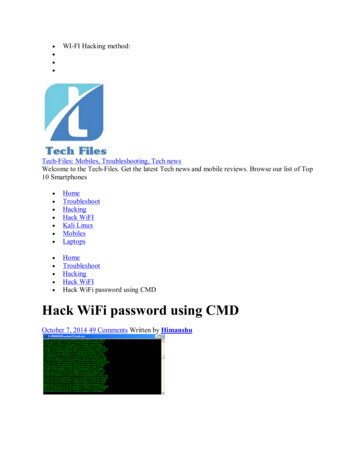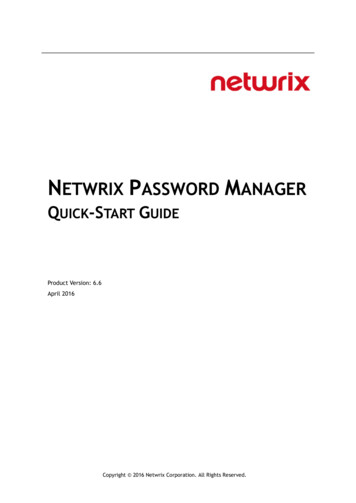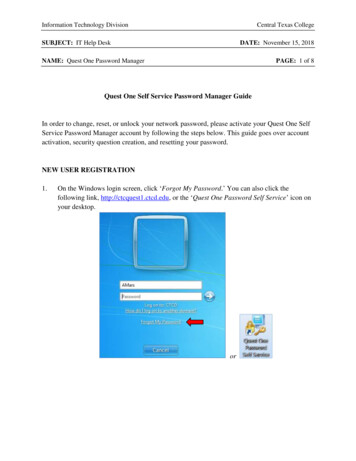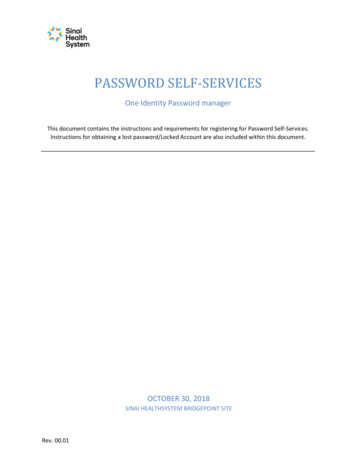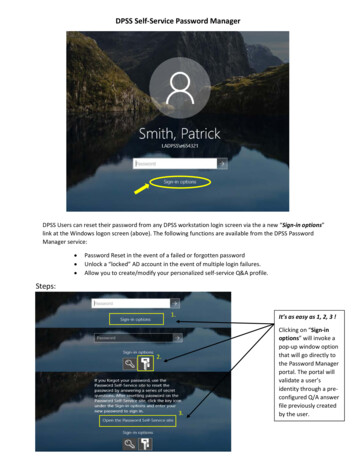
Transcription
TEACHER'S GUIDEPathfinder (Grade 4)Vol. 16 No. 5NatGeo.org/explorermag-resourcesPassword: explorer16Vol. 16 No. 5ExplorerPATHFINDERThis guide contains languagearts and science lessons forarticles in this issue of ExplorerPathfinder.Explorer MagazineExplorer classroom magazinesare specifically written foreach grade, 2-5. Throughgreat storytelling and stunningphotographs, the Explorermagazines develop literacyskills and teach standardsbased science content.The Explorer magazines striveto offer a variety of readingexperiences for students withdifferent ability levels in thesame class. Thus, all articleshave been measured using theLexile Framework for Reading.Some articles will be easier toread than others, but all articlesin Explorer Pathfinder will bewithin the 450-850L range.BigCatsIn This Guide2Explorer is part of NationalGeographic Explorer's Educationprogram. For more resources,visit the "For Teachers" tab onExplorer's website, natgeo.org/explorermag-resources.Seamounts 10Cave Symbols 16Your Subscription Includes: Magazines Classroom Posters P rojectable Magazine Interactive Whiteboard Lesson Teacher’s Guide App (additional subscription required)National Geographic Explorer, PathfinderPage 1Vol. 16 No. 5
ExplorerThe Four That RoarLANGUAGE ARTS730LObjectivesREAD Students will assess their familiarity with andknowledge of vocabulary words. Students will identify the overall structure of ideaspresented in the text. Students will explain concepts based oninformation in the text.Give students a few minutes to scan the article'simages in their student magazines. Then have themread the subheads. As a class, discuss how theimages and subheads are related.Resources Vocabulary Assessment Master (page 6) Language Arts Assessment Master (page 7)Summary The article “The Four That Roar” introducesstudents to four big cats—lion, leopard, jaguar,and tiger that share one unique trait: They roar.BUILD VOCABULARY AND CONCEPTS adaptation apex predator conservationist poach reserveAs a class, discuss the difference between familiarityand knowledge. Guide students to recognize thatthe more familiar you are with something, the moreknowledge you have. Challenge students to explainhow this concept applies to words when they read.Display the vocabulary words on a word wall or onthe whiteboard. Give each student a copy of theVocabulary Assessment Master. Instruct studentsto write each word on their papers. Review thecategories under the header “Familiarity withthe Word.” Tell students to make a checkmark toindicate how well they know each word.Guide students to recognize that the images showwhat the big cats look like. The subheads tell whatthey look like, how they act, and why that can leadto problems with humans. In essence, the subheadsare a road map that will guide them as they readabout the big cats they saw in the photos.Explain to students that there are four basic typesof text structure: chronology, comparison, cause/effect, and problem/solution. Review the basics ofeach. Then say: When you're reading an article thatgives multiple examples of the same thing, such asfour different kinds of big cats, chances are good thatthe author will use more than one type of text structurein the text. For example, how do the big cats hunt forprey? Do they do it in the same way or are there bigdifferences? If so, in the section that describes huntingbehaviors, the writer likely used comparison to outlinethose differences . As you read the entire article andidentify it's central focus, you will find that the writerrelied on one type of text structure to make the mainpoint. That is the overall structure of the text.Give each student a copy of the Language ArtsAssessment Master. Instruct students to circlewhat they think is the overall text structure used inthis article. Then have students read the article ontheir own. As they read, instruct students to identifyspecific sections where the writer used each typeof text structure. Challenge them to explain whythey think the writer chose a specific type of textstructure for each section.Instruct students to write what they think eachword means on their worksheets. Then displaythe Wordwise feature on page 9 of the projectablemagazine. Have students write those definitionson their worksheets and compare them with thedefinitions they wrote.National Geographic Explorer, PathfinderPage 2Vol. 16 No. 5
ExplorerThe Four That RoarLANGUAGE ARTSTURN AND TALKWRITE AND ASSESSHave students turn and talk to discuss what theylearned about the four big cats that roar. Ask: Whatare the four cats that can roar? (lion, leopard, jaguar,and tiger) What is one way these four big cats arealike? (Possible response: They are all carnivores.)What is one way they are different? (Possibleresponse: They have different patterns on theirfur.) Invite students to share what else they learnedabout the four big cats that roar.You may want students to write about what theylearned to assess understanding. Encouragestudents to reflect upon what they read and how itaffected their ideas about the topic. Identify Text Structure Review with studentsthe different types of text structure. Encouragestudents to identify what they think is the overall textstructure of this article. Challenge them to explainwhy. Then have students turn and talk to share theirLanguage Arts Assessment Masters with a partner.Did they identify the same sections for each type oftext structure? If so, did they explain the writer'schoice in the same way? If students identifieddifferent sections, do both of their selections makesense? If not, encourage partners to read thesection again. W hy are "King of the Jungle" and "Ghosts of theSavanna" good nicknames for big cats that roar? W hat is a conservationist? How do conservationistshelp big cats? W hat surprised you about what you read? Explain Concepts After reading the article, say:One way to see if you understand information is totry to tell someone else about the topic. If you can'texplain the concept, you might need to read the articleagain. Have students turn and talk to explain toa partner how why these four big cats can roar.Prompt discussion with questions such as: Why dothese four cats roar? (They all have a missing bone intheir voice boxes.) What do they have instead? (Theyhave a band of stretchy tissue.) Why do their roarssound different? (The more the band stretches, thelower the sound that is made when the air passesacross the vocal cords.) What sound would the catsmake if they didn't have the missing bone? (Theywould purr.)National Geographic Explorer, PathfinderPage 3Vol. 16 No. 5
ExplorerThe Four That RoarSCIENCEObjectives Students will compare and contrast the four bigcats that roar. Students will identify traits that help cats becomesuccessful hunters so they can survive. Students will recognize issues that lead toconflicts between big cats and humans.Resources Content Assessment Master (page 8) "The Four That Roar" poster (Teacher's Edition) "Know Your Cats" poster (Teacher's Edition) Comprehension Check (page 9) "The Four That Roar" Interactive Whiteboard(optional)Science BackgroundBig cats are the indisputable leaders in theirdomains. As apex predators, they reign at the topof the food chain. By limiting the number of planteaters and preying on the sick, they keep theirhabitats healthy and their ecosystems in check.Lions, tigers, jaguars, and leopards are fourof the most fearsome predators. In addition tobeing outstanding hunters, they are the only fourbig cats that can roar. This is possible becausethey all have a missing a bone in their voiceboxes.Despite their status, these four big cats—like allother big cats around the world—are in dangerof becoming extinct. One major problem they allface is the loss of habitat. As people clear landfor new homes and businesses, big cats' habitatsshrink. Their closer proximity to humans leads toinevitable conflicts between the two species.ENGAGETap Prior KnowledgePoll the class to see how many students have a petcat. Invite a few volunteers to describe their cats.What do the cats look like? How do they behave?Challenge the class to explain how domestic catsare similar to or different from big cats that live inthe wild.EXPLOREPreview the LessonDisplay the cover of the projectable magazine. Invitevolunteers to describe the big cat they see. Thenhave them describe the place where this big catlives. Ask: In what kind of environment does it looklike this big cat lives? ( a jungle) Point out the cat'steeth and claws. Ask: Based on these traits, how doyou think this big cat gets its food? (It hunts otheranimals.) Tell students that as they read the articlethey will learn why this behavior, which helps all bigcats survive, can also cause conflicts between bigcats and humans who live in the same environment.Set a Purpose and ReadHave students read the article in order to compareand contrast the four big cats that roar, identifytraits that help cats become successful hunters sothey can survive, and recognize issues that lead toconflicts between big cats and humans.Some people kill big cats. Farmers do this whenthe cats prey on their livestock. And poachers killso they can sell the cats' body parts. But otherpeople are trying to save big cats. They teachpeople how to live beside the predators. They setaside land for big cats to live on. They work toensure that all big cats can survive.National Geographic Explorer, PathfinderPage 4Vol. 16 No. 5
ExplorerThe Four That RoarSCIENCEEXPLAINELABORATECompare and Contrast Big CatsDisplay the "The Four That Roar" poster. Reviewthe poster with the class. Encourage students toidentify similarities between the big cats. (Possibleresponses: fur, sharp teeth, claws, etc.) Challengestudents to identify differences. (Possible responses:color and pattern of fur, size, and hunting habits)Then display the map on pages 6-7 of the projectablemagazine. Say: This map shows the big cats'approximate ranges, or the areas where they live. Asyou can see, their ranges are in different places. Ask:But what does the article tell you all of these rangeshave in common? (They're shrinking.) Give eachstudent a copy of the Content Assessment Master.Divide the class into small groups. Instruct groups toreview the article and the poster. Challenge them tocompare and contrast the four big cats that roar.Find Out MorePoint out to the class that the map on pages 6-7shows the current ranges of the four big cats thatroar. It does not show what their ranges were in thepast. Divide the class into groups. Instruct groupsto conduct research to learn more about theseshrinking habitats. How large did they used to be?What specifically caused them to shrink?Identify Traits that Help Cats SurviveDisplay pages 4-5 of the projectable magazine. Asa class, review the sections "Built to Hunt" and"Hunting Prey." Have students identify adaptationsthat help big cats catch prey. (Possible responses:long tails, claws, strong legs, etc.) Discuss how thecats use each adaptation. (Example: Strong legs andclaws help leopards climb trees.) Then display the"Know Your Cats" poster. Review the poster withthe class. Challenge students to identify adaptationsthat help these cats survive.EVALUATERecognizing Conflicts: Big Cats and PeopleDisplay the map on pages 6-7 of the projectablemagazine. Remind the class that this map showswhere big cats live. Ask: Who else lives in these sameplaces? (people) Divide the class into small groups.Instruct groups to review pages 6-9 of the article intheir student magazines. Then have students takeout their Content Assessment Masters. Tell them torecord problems that arise when big cats lose theirhabitats and solutions people have tried to solvethese problems. Have students explain whether ornot they think these solutions will be enough to savethe big cats from extinction.National Geographic Explorer, PathfinderExtend Your Thinking About Big CatsRemind students that in 2009 the NationalGeographic Society launched the Big Cats Initiative.Through conservation, education, and spreading theword about big cats, this program helps to ensurethe survival of all big cats. As a class, brainstorm alist of ideas that would help the Big Cats Initiativesucceed in its mission.Have students record their answers to theassessment questions in their science notebooks oron a separate sheet of paper. W hat is a conservationist? (a person who works toprotect and manage Earth's natural resources andthe wildlife that depends on those resources) H ow can a reserve help protect big cats frompoachers? (The animals on a reserve are protectedand they can roam freely. The people who protectthem are on the lookout for poachers.) H ow do photo safaris help save big cats? (Touristspay to go on photo safaris. The money they payis used to help the cats. Locals work for the tourcompanies. They earn their living from keeping theanimals safe.)If you wish, have students complete theComprehension Check to assess their knowledgeof concepts mentioned in the article. You may alsowish to examine the optional Interactive Whiteboardlesson that accompanies this article.Page 5Vol. 16 No. 5
NameVOCABULARY ASSESSMENT: The Four That RoarFamiliarity with the WordI've seen or I don't knowheard thethe word.word before.Page 6DateVol. 16 No. 5How the articledefinesthe word:Knowledge of the WordWhat I think theword means:Record information from the article about each vocabulary word.WordI know theword verywell.National Geographic Explorer, Pathfinder 2017 National Geographic Society. All rights reserved. Teachers may copy this page to distribute to their students.
NameDateLANGUAGE ARTS ASSESSMENT: The Four That RoarCircle what you think is the article's overall text structure. Identify sections that use eachtype of structure. Explain why the writer used certain types of structure in each section.Text StructureSectionExplanationChronology 2017 Nation
National Geographic Explorer, Pathfinder Page 5 Vol. 16 No. 5 ELABORATE Find Out More Point out to the class that the map on pages 6-7 shows the current ranges of the four big cats that roar. It does not show what their ranges were in the past. Divide the class into groups. Instruct groups
